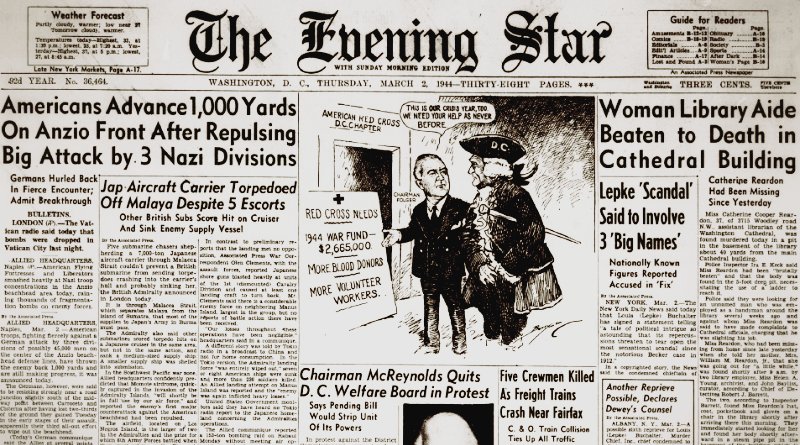World War II Chronicle: March 2, 1944
Click here for TODAY’S NEWSPAPER
As Japanese positions on Wake, Nauru, and the Marshalls are targeted by American bombers (see page two) Seventh Air Force commander Maj. Gen. Willis H. Hale says that he is confident the Japanese can be swept from the Pacific (page three). Hale earned the Navy Cross for leading a bombing raid against Nauru last year… George Fielding Eliot analyzes the German attack at Anzio on page eight…
Sports begins on page 14, featuring a Grantland Rice boxing column… A former Washington reporter who is now a B-17 gunner tells about his first bombing mission, where crews tried to resuscitate another gunner who lost his oxygen mask. The bombers are flying so high that not only is the oxygen thin, it is 40-plus degrees below zero. Considering you’re also getting shot at, it’s an unbelievably miserable experience.
Roving Reporter by Ernie Pyle
POMPEII, Italy — Maj. Ed Bland got fed up with flying for a living and I got fed up with writing for a living and Corp. Harry Cowe got fed up with being a corporal for a living, so the three of us said “To hell with it,” and we got into Major Bland’s jeep and came touring out to Pompeii.
The only thing in all Italy I have really wanted to see is the leaning tower of Pisa, but that’s up north and I will probably leave Italy before we get that far. So Pompeii is the first and probably last real sightseeing I will get to do in Italy.
Someone had told me he was disappointed in Pompeii because so little of the ruins had been uncovered, but I think he must have got on the wrong side of the mountain for there’s certainly plenty uncovered.
The buried city originally had 25,000 people, and two-thirds of the whole city has been dug out. The preserved part surely must be almost a mile square. Pompeii, as you may know, was buried by a rain of ashes and dust and cinders that covered the city 20 to 24 feet deep and smothered everybody to death.
The eruption didn’t come from Vesuvius, as most people think, but from Vesuvius’ sister volcano, named Somma, now extinct. The burying took place in 79 A.D. and the ruins weren’t rediscovered until the 18th Century.
When we stopped the jeep in the little barren square in front of the main gate to Pompeii, we were assaulted by a swarm of Italian urchins so grabby and insistent that we had to pick one out and appoint him to watch our jeep.
Then we bought tickets for 10 cents apiece and went through the turnstiles. A few Italian men in civilian clothes tagged along as we started to walk, asking if we wanted a guide.
We picked one out. Many of the guides spoke fruit-stand English, such as “Diss ees da bedaroom.” But ours spoke with quite a cultured accent. He said he once lived in New York, but had been a Pompeii guide since long before the war.
His name was Ugo Prosperi. He was tall and thin and looked American. He wore a fedora hat and a long dark overcoat with a fur collar and gray trousers and gray spats. He smoked a thick cigar and addressed us as “sir.”
There’s no use in my trying to describe Pompeii in a wartime column. Thousands of you back home have already seen it and the rest of you could hardly visualize it anyhow, so I will merely try to give you Pompeii’s wartime aspect.
Around 100 bombs have fallen within the old Pompeii since the war. The ruins, of course, have never been deliberately bombed by either side. The bombs that fell inside the walls were strays. Actually not much damage has been done. But our guide, spotting Major Bland as an Air Force man, made four or five deadpan but subtle digs about the bombings.
All we could do was wink at each other. Major Bland has dived-bombed a lot of Italy, but never around Pompeii.
Dozens of small parties were wandering around the ruins, each with a guide and all composed of military people on leave.
Down the street acme a British brigadier smoking a pipe and a Scottish officer wearing kilts. We turned a corner and met a group of naval ensigns in from the sea, all carrying canes as though they were on the college campus back in England.
There were gay young American fliers in leather jackets and groups of crumpled-looking doughboys on leave from the front lines eating peanuts.
War hasn’t made much difference in the scribbling habits of the Americans and British. On the walls of Pompeii you will see hundreds of names written in pencil — Pvt. Joe Doakes from Kansas City, Sergt. Jock McLean from Glasgow.
Pompeii is noted for the dirty pictures on the walls of certain houses. In peacetime the guides had to be discreet with mixed groups of tourists, but they don’t have to pull their punches now except when a bunch of nurses or WACs happens along.
As in peacetime they will sell you obscene little good-luck emblems in silver or bronze and books of “feelthy” photographs. Whether or not we bought any is a military secret.
Major Bland from Oklahoma and Corporal Cowe from Seattle and I from Indiana and New Mexico spent three hours in the ruins of old Pompeii and decided we enjoyed it, but the next time we go sightseeing we hope it can be through the less ancient ruins of Berlin.
Evening star. (Washington, D.C.), 2 March 1944. Chronicling America: Historic American Newspapers. Lib. of Congress.
https://chroniclingamerica.loc.gov/lccn/sn83045462/1944-03-02/ed-1/
